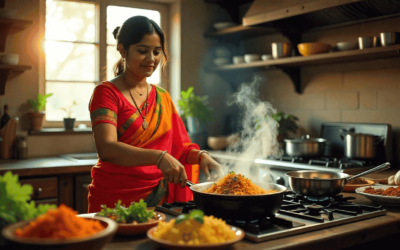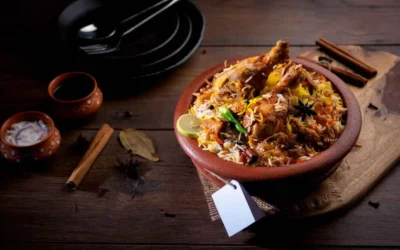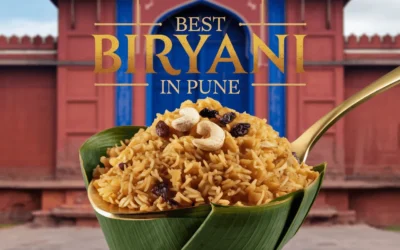26 Types of Biryani in India and Their Unique Flavors
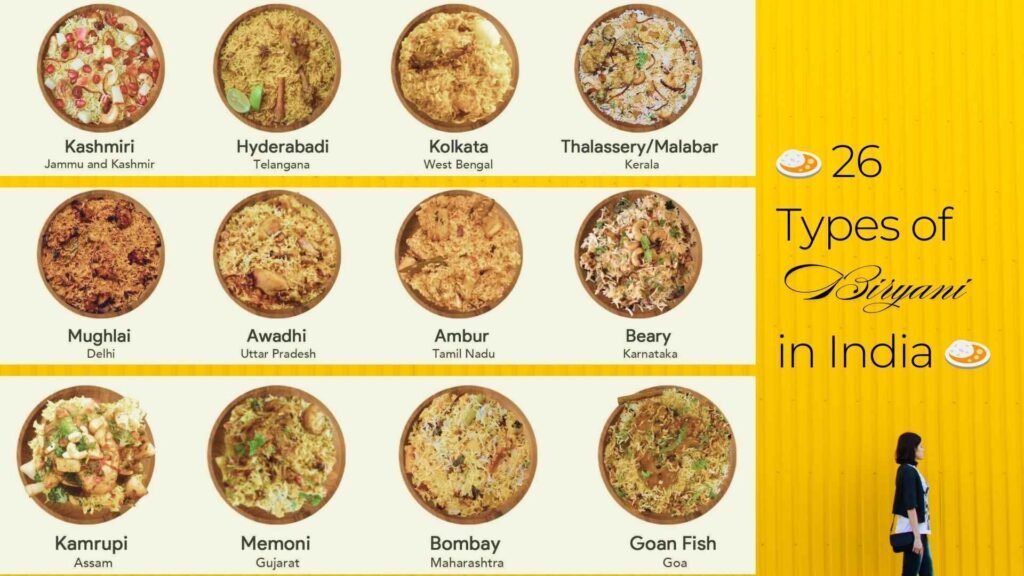
Biryani is not just a dish—it’s a celebration of flavours, traditions, and emotions that bring food lovers together across India. Each spoonful tells a story of its region, offering a perfect blend of fragrant rice, tender meat or vegetables, and bold spices.
Born in the royal kitchens of the Mughals, biryani evolved with regional adaptations, reflecting India’s diverse cultures and ingredients. From the fiery spices of Hyderabad to the subtle sweetness of Kolkata, each variety is a culinary masterpiece.
This blog explores India’s 26 types of biryani, each with its unique story, flavours, and traditions.
The Heritage of Biryani
The story of biryani begins in the royal kitchens of Persia and Central Asia, from where it travelled to India, finding its place in the courts of the Mughal emperors. The word “biryani” itself is believed to have originated from the Persian words “birian” (fried) and “birinj” (rice).
As biryani spread across India, it adapted to local cuisines and cultures, resulting in unique regional varieties. Ingredients like coconut in the south, dried fruits in the north, and the use of fish in coastal regions show how biryani embraced regional flavours.
What makes biryani truly special is its cooking technique. The dum style involves slow-cooking rice and meat in a sealed pot, locking in their flavours and aromas. This technique, combined with spices like saffron, cardamom, and cloves, creates the rich taste that biryani lovers cherish.
Popular Types of Biryani in India
North India
- Lucknowi (Awadhi) Biryani:
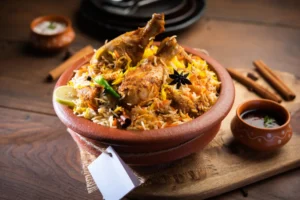
Originating in the kitchens of Nawabs in Lucknow, this biryani is inspired by Persian cuisine. Dum-cooked and mildly spiced, the meat and rice are slow-cooked with saffron and rose water, creating a delicate and aromatic flavour. It’s a regal treat for those who prefer subtle yet rich tastes. - Kashmiri Biryani: Reflecting Kashmir’s royal heritage, this biryani combines tender lamb, saffron, and dry fruits like almonds and raisins. The use of yoghurt and mild spices gives it a unique, creamy flavour. It is perfect for those who love a touch of sweetness in their meals.
- Sindhi Biryani: A gift from the Sindh province, now in Pakistan, this biryani is known for its bold flavours. Green chillies, mint, yoghurt, and dried plums create a tangy and spicy profile while adding potatoes, which makes it hearty and satisfying.
East India
- Kolkata Biryani:
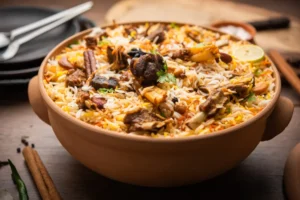
Influenced by Awadhi biryani, this variant became famous during the reign of Nawab Wajid Ali Shah, who brought it to Bengal. What sets it apart is the addition of potatoes and boiled eggs alongside lightly spiced meat and fragrant rice. The subtle sweetness of kewra water and rose essence are its hallmarks. - Nagpur Biryani: Known for its fiery heat, it incorporates a dry coconut masala unique to the Vidarbha region. Bold spices and slow cooking make it a favourite for spice lovers.
- Bamboo Biryani (Assamese Style): A culinary marvel from the Northeast, this biryani is cooked inside bamboo tubes over an open flame. The bamboo imparts a smoky, earthy flavour, making it a must-try for adventurous foodies.
South India
- Hyderabadi Biryani:
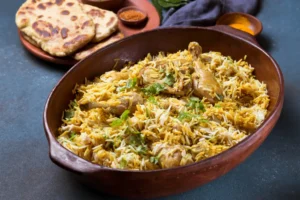
A legacy of the Nizams, this biryani perfectly blends Mughlai and Andhra flavours. Cooked in layers with basmati rice, marinated meat, fried onions, and saffron, it’s offered in kachchi (raw meat) and pakki (cooked meat). Its balance of heat and aroma is unmatched. - Malabar (Thalassery) Biryani: From Kerala’s coastal region, this biryani uses short-grain rice (jeerakasala) and a blend of sweet and savoury spices. Adding cashews, raisins, and fried onions makes it rich and festive.
- Dindigul Biryani: This biryani, which hails from Tamil Nadu, uses jeera samba rice and cube-shaped meat. The unique masala blend includes black pepper, which gives it a tangy and spicy kick.
- Ambur Biryani:
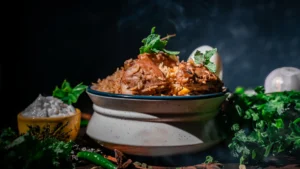
Originating from a small town in Tamil Nadu, this biryani stands out for its tangy flavour due to curd-marinated meat. Traditionally served with brinjal curry, it’s a favourite among travellers. - Chettinad Biryani: A fiery delicacy from Tamil Nadu, this biryani incorporates freshly ground spices, including black pepper, star anise, and cloves. The intense heat and bold flavours make it a standout.
- Kerala Prawns Biryani: This biryani is a seafood delight. It combines fresh prawns with coconut milk, curry leaves, and green chilli, a true reflection of Kerala’ssof Kerala’s coastal cuisine.
- Tamil Muslim Biryani: Known for its distinct green chilli flavour, it is often prepared for festive occasions and weddings. Its aromatic spices and long-grain rice make it a crowd-pleaser.
West India
- Bombay Biryani: A blend of sweetness, tanginess, and spice, this biryani often includes dried fruits and fried potatoes. Layers of basmati rice, marinated meat, and a touch of kewra water create its unique flavour.
- Jodhpuri Biryani is a bold Rajasthani variant featuring red chillies, garlic, and yogurt-marinated meat. The intense flavours reflect the region’s vibrant culture.
- Goan Fish Biryani: This biryani is a tribute to Goan cuisine, combining coastal spices, fresh seafood, and the tanginess of vinegar.
Hidden Gems and Lesser-Known Varieties
- Memoni Biryani: Popular among the Memoni community in Gujarat and Sindh, this biryani is spicy and uses fewer ingredients, focusing on the meat’s natural flavours.
- Beary Biryani: A unique coastal Karnataka variety cooked with coconut milk and mild spices, offering a subtle and creamy flavour.
- Coorgi Pandi Biryani: From the hills of Coorg, this pork biryani is robust and spicy, featuring ingredients like kachampuli (Coorg vinegar).
- Mangalore Biryani: This biryani highlights Karnataka’s coastal flavours. It uses a blend of coconut and bold spices for a rich taste.
- Bhatkali Biryani: A speciality of the Nawayath Muslim community in Karnataka, this biryani layers rice with curd-marinated meat, onions, and green chillies.
- Rajput Biryani is a royal Rajasthani treat featuring game meats like quail or venison, spiced with traditional ingredients like dried chillies and garlic.
- Tahari Biryani:
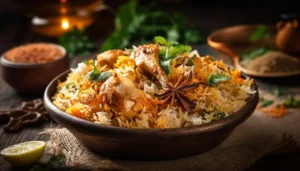
A vegetarian take on biryani featuring fragrant basmati rice cooked with seasonal vegetables and mild spices. - Kalyani Biryani: Also called the poor man’s Hyderabadi biryani,” this version uses cheaper cuts of meat and simpler spices but delivers bold flavours.
- Chennai Biryani: A quick and flavorful biryani with bold spices and short-grain rice reflecting the hustle of urban Chennai.
- Andhra Biryani: This biryani is characterized by its fiery heat and tangy flavours. It often includes tamarind and is served with spicy gravy.
The Art of Making Biryani
Creating biryani is an art that requires precision and patience. The foundation lies in its techniques:
- Dum Cooking: This traditional slow-cooking method involves sealing the pot with dough to lock in steam and flavour. The rice and meat cook together, allowing the spices to infuse deeply.
- Kacchi and Pakki Styles:
- Kacchi Style: The raw marinated meat is layered with rice and cooked together, ensuring every grain of rice absorbs the juices of the meat.
- Pakki Style: Before slow cooking, the meat is pre-cooked and layered with partially cooked rice.
- Layering: A hallmark of biryani, the layering of rice, meat, fried onions, and saffron adds depth to the flavour and ensures every bite is delightful.
- Spices and Aromatics: From whole spices like cinnamon, cloves, and cardamom to the finishing touches of saffron and kewra water, the aromatics elevate biryani to a gourmet level.
Perfect Pairings
To enjoy biryani at its best, pair it with these accompaniments:
- Raita: A cooling yogurt-based side dish with cucumber, onions, or boondi.
- Salan: A rich, spicy gravy made with peanuts, sesame seeds, and tamarind.
- Papad and Pickles: Add crunch and a tangy kick to balance the flavours.
- Drinks: Sweet lassi, masala chaas, or chilled beer to complement the spices.
Why You Should Explore These Biryani Varieties
Each biryani has a story to tell, reflecting its region’s culture, ingredients, and traditions. Here is why you should embark on a biryani journey:
- Diversity: From fiery Andhra biryani to the creamy Kashmiri version, every palate has a biryani.
- Cultural Connection: Discover the history and traditions behind each recipe.
- Flavour Explosion: Experience the harmony of spices, rice, and protein that make biryani a global favourite.
These types of biryani in India reflect the country’s culinary diversity and rich history.
Craving the rich flavours of biryani? Don’t wait any longer!
- Dine-In: Visit Infinity Biryani Studio in Pune to savour authentic Tamil-style biryani.
- Order Biryani Online: Bring the magic of biryani to your home with a few clicks.
India’s biryani varieties are a testament to the country’s culinary diversity. Each region has contributed its twist to this beloved dish, making it a mosaic of flavours and traditions. Exploring these types of biryani in India is more than just tasting food; it’s about experiencing the culture of each region.
From Lucknow’s royal kitchens to Kerala’s coastal delicacies, biryani is more than just food—it’s an experience. So, the next time you crave something special, remember: there’s a biryani waiting to be discovered. Bon appétit!
Author: Manish Pandey
Website: https://publicmediasolution.com/

